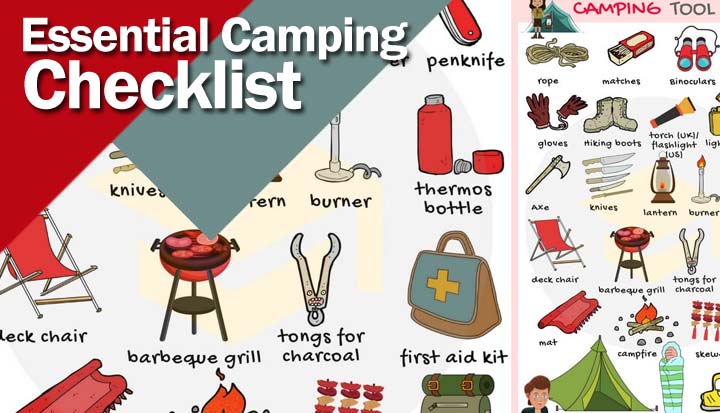Excited for your upcoming camping trip, but not really sure where to start when it comes to packing? That’s where a camping checklist can come in handy. To help you get started, we’ve compiled a list of gear you may or may not decide that you need to take with you on your camping holiday. Even if you’re a camping expert and think you’re all set, it never hurts to double check a good list – you might remember something you’ve forgotten, or realize you need something you never thought you needed.
The comprehensive camping checklist below covers everything from the type of tent you should bring all the way down to the small stuff you may not have thought to pack, like tin foil and a roll of duct tape. Whether you’re going on a family camping trip, to a festival, or just camping for the heck of it, we’ve got you covered.
Camping Tent Checklist
Sleeping out under the stars sounds great in theory, but if you don’t want to be drenched by a rainstorm or eaten up by bugs, you’re probably going to want to bring a tent. What type of tent should you bring? That depends on how many people are in your group, your camping skills, and your budget.
Types of Camping Tents
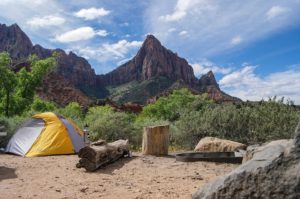
Pop-up tents:
These tents are gaining rapid popularity because they’re so easy to set up – just open it up and wham, instant tent. You don’t have to be a camping expert by any means to use a pop-up tent, which is why they’ve been hugely popular at outdoor music festivals. Aside from being ready to use in seconds, they’re also some of the most affordable tents on the market.
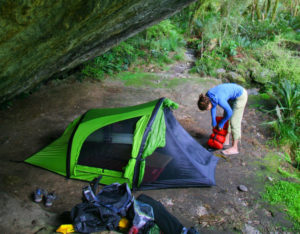
Inflatable tents:
Comparable to pop-up tents in speed and ease of use – with a little air, the tent assembles itself in a few minutes. The tent material itself isn’t inflatable, but the poles are. A relatively new innovation in the camping world, inflatable tents were designed to be stronger than their more traditional counterparts, and are often tall enough to allow for standing room. However, this also means that they’re pricier and a bit heavier than the average tent.
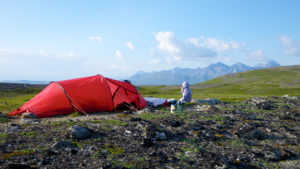
Backpacking Tents:
For the rugged adventurer, lugging around a heavy folded tent on your back all day isn’t exactly ideal, but you still need a place to sleep at night. Small and lightweight, backpacking tents are designed with hikers in mind. Practical, but not luxurious, these are strictly one person.
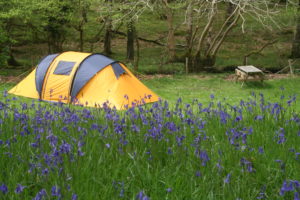
Family Tents:
A big family is going to need a big tent, especially if you have young children you need to keep an eye on. Like a little house, family tents have separate “rooms”, allowing for big families to coexist peacefully (no kicking each other in the middle of the night!) and for groups of friends to have a bit of privacy. It’s not surprising that the bigger the tent, the more expensive it is, and assembling a family tent is going to be a group effort for sure.
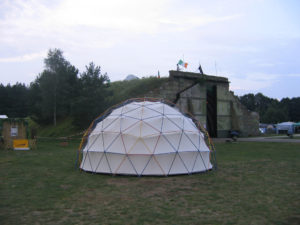
Geodesic Tents:
If you’re camping out in extreme weather, a geodesic tent is one of the sturdiest options out there. A great wind resistor, this one’s for pros and adventure seekers.

Ridge Tents:
If I asked you to draw a tent, you’d probably draw a ridge tent. These are the classic triangle tents that have been around for ages, and while they’re falling out of style, they’re still a simple and easy shelter to set up. Best for one, two people at most.
Related: Most common types of Tents
Tent Accessories
Now that you’ve chosen a tent, the next thing on our camping checklist is tent accessories. Sure, you could just bring the tent kit alone, but as Murphy’s Law states: anything that can go wrong, will go wrong. Packing a little extra gear can prevent some big problems, and you won’t be able to run to the store once you’re at the campsite. Here are some things to pack to keep your tent in shape:
- Extra pegs: Just in case you end up needing them.
- Mallet: Easier than using your foot!
- Brush and dust pan: You’re going to be tracking dirt into your tent, and no one wants to sleep in a dirty tent.
- Duct tape/emergency sewing kit: Accidents happen. In the event that your tent rips, you’re going to need a way to patch it up to keep it waterproof. Plus, duct tape has a thousand other uses – it can be used to fix a broken pair of glasses, secure a billowing tablecloth, repair shoes, and more.
First-Aid Checklist
Far away from town where medical help is always close by, prepping for possible injury on a camping trip is crucial. Taking care of a small cut immediately can prevent a nasty infection later. Plus, you’re going to want a way to prevent and treat common outdoor related problems like allergies, sunburn, and bug bites, so that everyone can enjoy the trip to the fullest.
- Bandages: Cuts and scrapes are bound to happen out on a camping trip, so bandages should be kept on you at all times, even away from the main campsite. Clean and treat wounds with an antiseptic ointment before applying.
- Antiseptic ointment: Better safe than sorry!
- Gauze: For more serious injuries.
- Moleskin: If you’re doing a lot of hiking, blister dressings can be a lifesaver.
- Medications: If you need to take a certain medication daily, pack more than you think you’ll need. When it comes to your health, it’s always better to be safe than sorry.
- Inhaler (for asthma)
- Allergy relief: Over-the-counter medication and a healthy supply of tissues are essential for anyone camping with allergies. If you have severe allergies to something you may encounter out in the wilderness (bees, certain nuts), bring an epinephrine injection if necessary and know directions to the nearest ER.
- Symptom treatment medication: Bring whatever you usually take for headaches, stomachaches, and cold symptoms, because you can’t be certain someone won’t get sick on your trip. These medications might not be cures, but they can keep someone comfortable.
- Antibacterial soap: Frequent hand-washing is important to prevent soil-related bacterial and fungal infections.
- Sunscreen: Even if you spend most of your time under the shade of the trees, the sun’s rays can still be harmful.
- Bug repellent: You want to spend more time enjoying your trip than itching at mosquito bites, after all.
- Aloe ointment: If the sunscreen doesn’t work or if you forget to apply bug spray, you’ll be glad you brought a soothing aloe ointment to treat your burning or itching skin.
- Warm clothing: Hats, gloves, boots, long underwear, and lots of layers.
- Weather resistant clothing: Rain jacket, rain boots, quick drying pants (so not denim!).
Comfort Checklist
If you’ve never been camping before, you might not realize how uncomfortable sleeping on the ground can be without the right gear. A bad bedtime set-up can lead to grogginess and back problems in the morning, so don’t rule these creature comforts out on your own camping checklist.
- Sleeping bag: The type of sleeping back you need depends on the time of year. Because weather is so unpredictable, it’s always better to take a sleeping bag that can handle even lower temperatures than what you expect to face on your trip.
- Sleeping pads: A lot of different things can act as a sleeping pad or mat, including pool floats, yoga mats, or just a whole mess of blankets piled on top of each other will work. But if you really want to be cozy, there are sleeping pads made for camping that are softer and better insulated.
- Pillows
- Blankets
- Ear plugs: The outdoors are not as tranquil as you might imagine – chirping crickets and hooting owls can keep you up all night!
- Eye mask
Food Checklist
Outdoor activities like hiking and rafting take a lot of energy, so you’re going to need to eat well. While roasted weenies and canned beans over an open flame may work for some people, others prefer a bit more flavor in their meals. Especially if you’re camping with family or friends, you’re going to want to be able to make them something a bit better than s’mores for dinner.
Types of Camping Stoves
- Dutch oven: If you want to feed a lot of people, eat gourmet outdoor meals and don’t plan on setting up camp too far out, a Dutch oven is a great option. These heavy pots can cook anything from pasta to ribs. Some even have lids that can be flipped over to create a griddle.
- Two burner/one burner stove: Lighter than the Dutch over and still great for groups are two burner propane stoves. While still not something you’d want to hike with, they’re a much more affordable option. Even more affordable are one burner stoves, which are light enough to hike with.
- Alcohol stove: For backpackers, the alcohol stove is the smallest, cheapest, and most lightweight option available. They take a bit longer than propane or butane stoves to get going, but once they do the result is the same.
Related Post: The Best Camping Stoves: Review 2020
Utensils and Food Storage
- Fuel: Depending on your camping stove, you’ll either need propane, butane, or alcohol.
- Matches/fire starter
- Cooking grate: Transforms a simple camping stove into a BBQ grill.
- Water container
- Water purification system: Lakes and rivers, no matter how beautiful they look, are full of harmful bacteria that can make you sick, which is why a water filter or purifier is so important. For large groups, consider a pump filter or a gravity filter. For individuals, filtered bottles and straws are less cumbersome. Boiling water over a camping stove is another option, but consumes more time and fuel.
- Coolers: Make sure to choose something sturdy and secure to keep animals out.
- Pots and pans
- Potholders
- Skewers
- Tin foil
- Plates/bowls/napkins
- Tablecloth
- Trash bags: Littering is the ultimate insult to Mother Nature – don’t do it! Keep trash bags away from your sleeping area in case a curious and hungry animal catches a whiff of the discarded food inside.
- Can opener: What camping checklist is complete without a can opener, the ultimate “shoot, I wish I brought one” item.
- Bottle opener: There’s nothing worse than pulling a cool beer out of your cooler and realizing you forgot a bottle opener. Sure, there are other ways to open a bottle, but save yourself the hassle!
- Cutlery (forks/knives/spoons)
- Biodegradable soap
- Basin/bucket: Something to wash dishes in.
- Folding chairs/tables: Especially for family camping trips, creating a space to sit and relax and enjoy a meal is important.
Related Article: Best Camping Cooking Gear – Equipment List
Hygiene Checklist
Camping is a time to get in touch with our more natural side, put our fingers in the dirt and our toes in the river. But if you’re camping with others, nobody wants to get a whiff of your natural smell. This section of the camping checklist outlines some things you can pack to keep yourself reasonably clean under the circumstances.
- Portable shower: If you’re going to be camping for a few days, you’re going to need a way to wash up. Rivers and streams aren’t very sanitary and don’t do much to make you smell better, which is why portable showers are a great option. They’re easy to use and cheaper than you may think.
- Soap
- Wipes: If you can’t bring a portable shower, you can take a “hillbilly shower” by rubbing wet wipes all over your body. Don’t try to spritz up afterward with cologne or perfume – it attracts bugs.
- Wash cloths/towels
- Hand sanitizer
- Mirror
- Nail clippers/files
- Feminine hygiene products: Dealing with your period on a camping trip sucks, but it’s doable, especially with a silicone menstrual cup that can be rinsed and reused.
- Toilet paper: A must-pack, unless you want to use leaves!
- Plastic bags
- Deodorant
- Clean change of clothes/underwear/socks
- Dental floss
- Toothbrush/toothpaste
- Lip balm
Other Supplies
To wrap up our camping checklist, a few oddball supplies that fall under the miscellaneous category. That doesn’t mean they’re any less important!
- Flashlight/lantern: There aren’t any street lamps or light switches on a camping trip, so make sure you’re able to see at night! Pack extra lantern fuel or batteries just in case.
- Batteries: In case the aforementioned flashlight dies.
- Pocket knife/multi-tool
- Hatchet
- Radio
- Compass/GPS
- Swimsuit
- Rope: It’s always good to have rope, even if you just end up using it as a clothes line.
- Entertainment: While you probably have enough planned to keep yourself busy on your camping trip, it’s good to have some games to play when you have downtime, especially if you’re camping with kids. A football, soccer ball, or Frisbee can keep kids (and adults!) busy for hours. Or if sports aren’t your thing, bring some cards, word puzzles, or a book.
- Camera: Keep the memories that you create!
Prepare for Your Next Camping Adventure with Camping Checklist World
Everyone’s camping checklist will be different, and hopefully, you’re able to craft your own unique list from ours. Start checking items off your list by checking out our selection of overstocked camping gear at Camping Checklist World, or check out some more of our camping tips and guides to prep yourself for your next trip.
Our other important checklists

